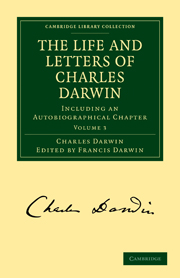Book contents
- Frontmatter
- Contents
- CHAPTER I THE SPREAD OF EVOLUTION. ‘VARIATION OF ANIMALS AND PLANTS’—1863–1866
- CHAPTER II THE PUBLICATION OF THE ‘VARIATION OF ANIMALS AND PLANTS UNDER DOMESTICATION’—JAN. 1867–JUNE 1868
- CHAPTER III WORK ON ‘MAN’—1864–1870
- CHAPTER IV THE PUBLICATION OF THE ‘DESCENT OF MAN.’ THE ‘EXPRESSION OF THE EMOTIONS’—1871–1873
- CHAPTER V MISCELLANEA, INCLUDING SECOND EDITIONS OF ‘CORAL REEFS,’ THE ‘DESCENT OF MAN,’ AND THE ‘VARIATION OF ANIMALS AND PLANTS’—1874–1875
- CHAPTER VI MISCELLANEA (continued). A REVIVAL OF GEOLOGICAL WORK—THE BOOK ON EARTHWORMS—LIFE OF ERASMUS DARWIN—MISCELLANEOUS LETTERS—1876–1882
- BOTANICAL LETTERS
- CHAPTER VII FERTILISATION OF FLOWERS—1839–1880
- CHAPTER VIII THE ‘EFFECTS OF CROSS- AND SELF-FERTILISATION IN THE VEGETABLE KINGDOM’—1866–1877
- CHAPTER IX ‘DIFFERENT FORMS OF FLOWERS ON PLANTS OF THE SAME SPECIES’—1860–1878
- CHAPTER X CLIMBING AND INSECTIVOROUS PLANTS—1863–1875
- CHAPTER XI THE ‘POWER OF MOVEMENT IN PLANTS’—1878–1881
- CHAPTER XII MISCELLANEOUS BOTANICAL LETTERS—1873–1882
- CHAPTER XIII CONCLUSION
- APPENDICES
- INDEX
CHAPTER XII - MISCELLANEOUS BOTANICAL LETTERS—1873–1882
Published online by Cambridge University Press: 29 August 2010
- Frontmatter
- Contents
- CHAPTER I THE SPREAD OF EVOLUTION. ‘VARIATION OF ANIMALS AND PLANTS’—1863–1866
- CHAPTER II THE PUBLICATION OF THE ‘VARIATION OF ANIMALS AND PLANTS UNDER DOMESTICATION’—JAN. 1867–JUNE 1868
- CHAPTER III WORK ON ‘MAN’—1864–1870
- CHAPTER IV THE PUBLICATION OF THE ‘DESCENT OF MAN.’ THE ‘EXPRESSION OF THE EMOTIONS’—1871–1873
- CHAPTER V MISCELLANEA, INCLUDING SECOND EDITIONS OF ‘CORAL REEFS,’ THE ‘DESCENT OF MAN,’ AND THE ‘VARIATION OF ANIMALS AND PLANTS’—1874–1875
- CHAPTER VI MISCELLANEA (continued). A REVIVAL OF GEOLOGICAL WORK—THE BOOK ON EARTHWORMS—LIFE OF ERASMUS DARWIN—MISCELLANEOUS LETTERS—1876–1882
- BOTANICAL LETTERS
- CHAPTER VII FERTILISATION OF FLOWERS—1839–1880
- CHAPTER VIII THE ‘EFFECTS OF CROSS- AND SELF-FERTILISATION IN THE VEGETABLE KINGDOM’—1866–1877
- CHAPTER IX ‘DIFFERENT FORMS OF FLOWERS ON PLANTS OF THE SAME SPECIES’—1860–1878
- CHAPTER X CLIMBING AND INSECTIVOROUS PLANTS—1863–1875
- CHAPTER XI THE ‘POWER OF MOVEMENT IN PLANTS’—1878–1881
- CHAPTER XII MISCELLANEOUS BOTANICAL LETTERS—1873–1882
- CHAPTER XIII CONCLUSION
- APPENDICES
- INDEX
Summary
[The present chapter contains a series of miscellaneous letters on botanical subjects. Some of them show my father's varied interests in botanical science, and others give account of researches which never reached completion.]
BLOOM ON LEAVES AND FRUIT
[His researches into the meaning of the “bloom,” or waxy coating found on many leaves, was one of those inquiries which remained unfinished at the time of his death. He amassed a quantity of notes on the subject, part of which I hope to publish at no distant date.
One of his earliest letters on this subject was addressed in August, 1873, to Sir Joseph Hooker:—
”I want a little information from you, and if you do not yourself know, please to enquire of some of the wise men of Kew.
”Why are the leaves and fruit of so many plants protected by a thin layer of waxy matter (like the common cabbage), or with fine hair, so that when such leaves or fruit are immersed in water they appear as if encased in thin glass? It is really a pretty sight to put a pod of the common pea, or a raspberry into water. I find several leaves are thus protected on the under surface and not on the upper.
”How can water injure the leaves if indeed this is at all the case?”
On this latter point he wrote to Sir Thomas Farrer:—
“I am now become mad about drops of water injuring leaves. Please ask Mr. Paine whether he believes, from his own experience, that drops of water injure leaves or fruit in his conservatories.
- Type
- Chapter
- Information
- The Life and Letters of Charles DarwinIncluding an Autobiographical Chapter, pp. 339 - 354Publisher: Cambridge University PressPrint publication year: 2009First published in: 1887

